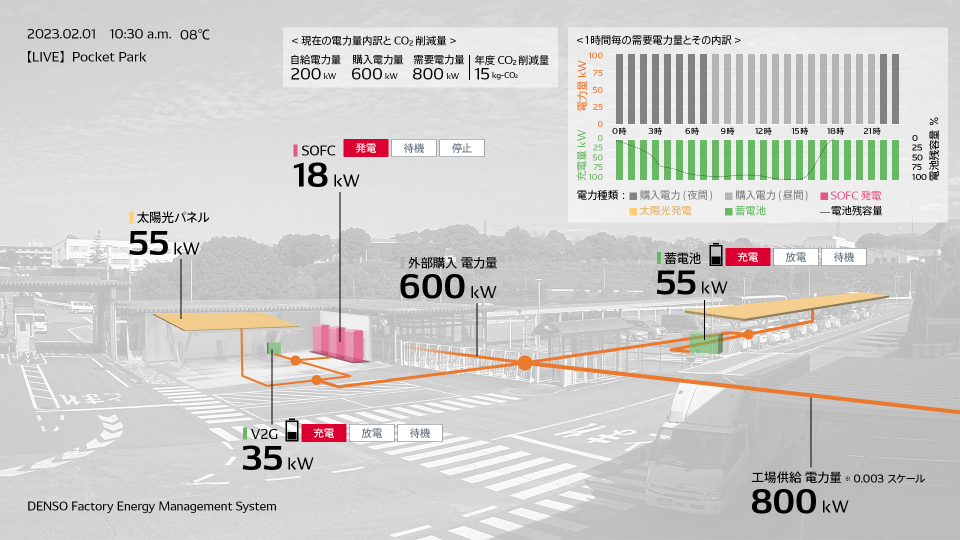Nishio Plant Pocket Park2024.03.12
To communicate DENSOʼs efforts toward carbon neutrality, we designed an energy management demonstration space at the Nishio Plant.

Creating Experiences to Understand Carbon Neutral Efforts
As part of DENSOʼs initiatives toward carbon neutrality, an energy management demonstration facility has been established at the Nishio Plant, one of DENSOʼs production facilities. DENSO DESIGN was responsible for the spatial and communication design of this facility.
The demonstration space is equipped with a SOFC (Solid Oxide Fuel Cell), solar panels, V2G (Vehicle-to-Grid), and storage batteries. The system operates by storing electricity generated from solar power, producing electricity from city gas, and using stored electricity during nighttime or rainy days. It optimally manages the energy state according to the weather and factory operation conditions.
Given the increasing ability to perform tasks remotely, we designed the space with the intention of providing visitors with a unique, real-life experience. Additionally, we aimed to leave a strong impression of the "DENSO Carbon Neutral Solutions" brand for those who read news releases or media articles.

Designing a Space with Media Appeal
To symbolize the efforts towards carbon neutrality at the Nishio Plant, we designed the demonstration space with a white base to make it stand out from its surroundings. The design incorporates graphics and greenery, ensuring that the SOFC system, the centerpiece, attracts attention.
We also considered how photos and videos would be taken during media coverage, pondering angles and compositions that would effectively convey the intended message.

DENSO Begins Demonstration of Energy Management System Utilizing High-Efficiency SOFC
[News Release]
Accelerating Efforts Toward Carbon Neutrality
DENSO Begins Demonstration of Energy Management System Utilizing High-Efficiency SOFC in Factory | Newsroom | News | DENSO - DENSO Corporation / Crafting the Core /
On-Site Presentation System
In addition to designing the space, DENSO DESIGN created a presentation system to explain the flow and mechanisms of energy to visitors. Starting from the UX perspective of "the visitorʼs story," we designed experiences using tablets and fixed signage. Presenters can use the main terminal to play technical explanation videos and switch to real-time views of power generation, charging levels, and energy status on tablets while conversing with visitors. Some aspects of the energy flow are complex, so the system allows changing perspectives to a birdʼs eye or angled view.
To provide a sense of real-time presence, we used live-action footage to show the energy flow scenes. To illustrate how weather affects power generation, we included changes corresponding to cloudy or rainy conditions. During the filming of live-action footage, we searched for suitable angles on rooftops and corridors, and ultimately, the most appropriate angle was found through the window of the menʼs restroom.
To encourage visitors to consider implementing the system, it is crucial to clearly communicate the benefits. In terms of UI, selecting the right information is essential. Displaying all information would make it too complex and less effective. We focused on organizing the information to ensure the technologyʼs advantages are conveyed, even to those unfamiliar with such products.








Tags
Member
Creative Direction: Yuji Tsuchiya
Project Management: Yuji Tsuchiya
Project Lead: Tasuku Matsumura
Art Direction: Tasuku Matsumura
Graphic Design: Tasuku Matsumura
UI Design: Yuki Yoshioka,Takafumi Tomono
Space Design:Shohei Yamashita,Takafumi Tomono
Other WorksAll Works
ActivitiesAll Activities









